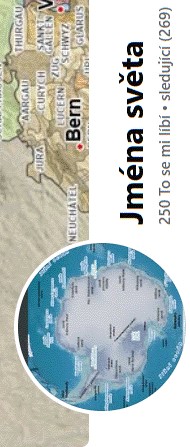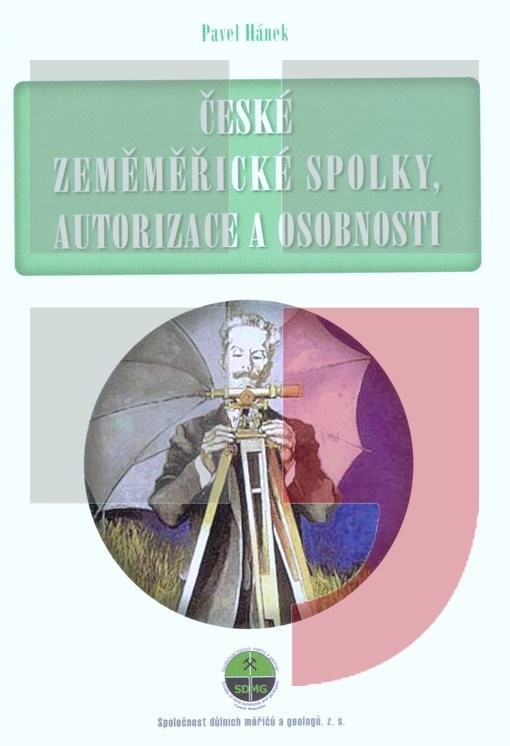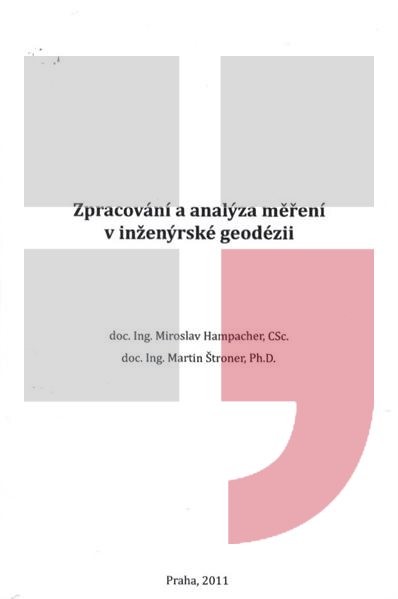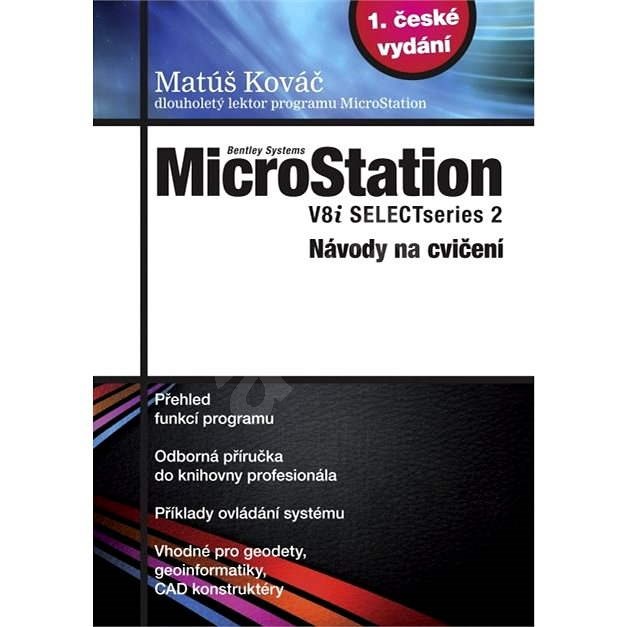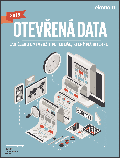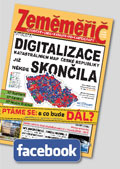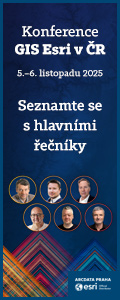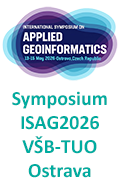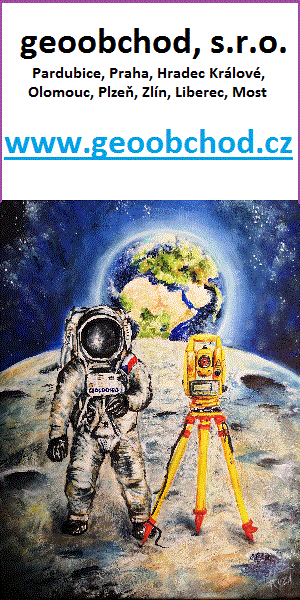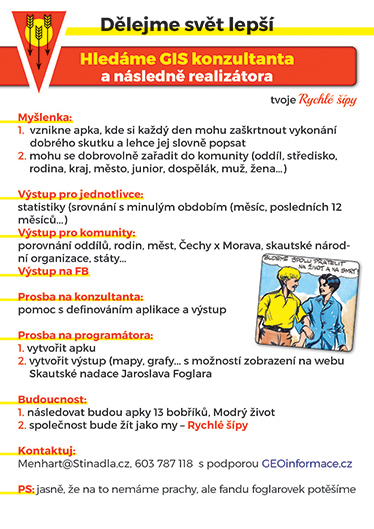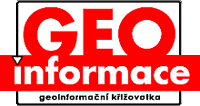zprávy
zdroje zpráv:Účelová mapa povrchové situace Digitální technické mapy
4.5.2017 2:00 Cenia - Katalog metadat ČR - INSPIRE ÚMPS Digitální technické mapy Plzeňského kraje - geodeticky měřený skutečný stav území - polohopis a výškopis, která v digitální podobě zobrazuje všechny objekty reálného světa (např. budovy, silnice, sloupy, stromy atd.). Aktualizace ÚMPS probíhá pomocí jednotlivých aktualizačních zakázek prostřednictvím geodetického měření a nebo formou plošného mapování.Objektová mapa povrchové situace Digitální technické mapy
4.5.2017 2:00 Cenia - Katalog metadat ČR - INSPIRE V rámci rozšíření poskytovaných služeb Plzeňským krajem v oblasti geografických informací byla v projektu Digitální technické mapy vytvořena nová datová sada, tzv. „Objektová mapa povrchové situace“ (dále jen OMPS), která je odvozenou mapou z datového skladu digitální technické mapy Plzeňského kraje.Mapa je k dispozici na území obcí a měst, kde proběhlo plošné mapování a doplnění ÚMPS DTM PK.Vymezení aktualizačních zakázek DTM PK
4.5.2017 2:00 Cenia - Katalog metadat ČR - INSPIRE Plošné vymezení jednotlivých aktualizačních zakázek Digitální technické mapy Plzeňského kraje, zobrazující územní rozsah poskytovaných geodat pro jednotlivé zakázky serveru Digitální technické mapy Plzeňského kraje (DTM PK).Modul ZAKÁZKA Digitální technické mapy Plzeňského kraje - aplikace
4.5.2017 2:00 Cenia - Katalog metadat ČR - INSPIRE Webová aplikace včetně mapové služby, která je vstupní branou pro Digitální technickou mapu Plzeňského krajeOznámení o vyhlášení výběrového řízení na služební místo vrchní referent / rada oddělení rozpočtu, odbor ekonomický
4.5.2017 0:00 Státní pozemkový úřad Ústřední ředitelka Státního pozemkového úřadu, jako služební orgán příslušný podle § 10 odst. 1 písm. f) zákona č. 234/2014 Sb., o státní službě (dále jen „zákon“), vyhlašuje výběrové řízení na služební místo vrchní referent / rada oddělení rozpočtu, odbor ekonomický.Oznámení o vyhlášení výběrového řízení na služební místo rada/odborný rada oddělení převodu majetku státu, Krajský pozemkový úřad pro Jihomoravský kraj
4.5.2017 0:00 Státní pozemkový úřad Ústřední ředitelka Státního pozemkového úřadu, jako služební orgán příslušný podle § 10 odst. 1 písm. f) zákona č. 234/2014 Sb., o státní službě (dále jen „zákon“), vyhlašuje výběrové řízení na služební místo rada/odborný rada oddělení převodu majetku státu, Krajský pozemkový úřad pro Jihomoravský kraj.Oznámení o vyhlášení výběrového řízení na služební místo ředitel Krajského pozemkového úřadu pro Ústecký kraj
4.5.2017 0:00 Státní pozemkový úřad Ústřední ředitelka Státního pozemkového úřadu, jako služební orgán příslušný podle § 10 odst. 1 písm. f) zákona č. 234/2014 Sb., o státní službě (dále jen „zákon“), vyhlašuje výběrové řízení na služební místo ředitel Krajského pozemkového úřadu pro Ústecký kraj.Informace ke směnám nemovitostí
4.5.2017 0:00 Státní pozemkový úřad Státní pozemkový úřad (SPÚ) může dle Zákona o půdě směnit a směnou nabýt nemovitosti.Podmínky směn nemovitých věcí jsou vymezeny metodickým pokynem SPÚ pro zpracování směn nemovitostí a zákony.
Oznámení o přerušení provozu Pobočky Benešov
4.5.2017 0:00 Státní pozemkový úřad Z důvodu přerušení dodávky elektřiny bude v úterý 16. 5. 2017 přerušen provoz Pobočky Benešov (KPÚ pro Středočeský kraj a hl. m. Praha).Vyhlášení Mapy roku 2016
3.5.2017 16:08 Česká kartografická společnost Vyhlášení Mapy roku 2016 proběhne 11.5.2017 ve 13:00 v rámci knižního veletrhu Praha, Výstaviště Holešovice.Odborný rada – vedoucí oddělení dokumentace katastru nemovitostí Katastrálního pracoviště Karviná, K
3.5.2017 15:42 ČÚZK /Urady/Katastralni-urady/Katastralni-urady/Katastralni-urad-pro-Moravskoslezsky-kraj/Uredni-deska/Oznameni-a-jina-uredni-sdeleni/Volna-mista/odborny-rada-–-vedouci-oddeleni-dokumentace-ka-(1)Odborný rada – vedoucí oddělení dokumentace katastru nemovitostí Katastrálního pracoviště Karviná, K
3.5.2017 15:42 ČÚZK - předpisy a opatření Katastrální úřad pro Moravskoslezský kraj Katastrální pracoviště Karvinávypisuje výběrové řízení na místo odborný rada – vedoucí oddělení dokumentace katastru nemovitostí
Odborný rada – vedoucí oddělení dokumentace katastru nemovitostí Katastrálního pracoviště Karviná, Katastrálního úřadu pro Moravskoslezský kraj
Odborný rada – vedoucí oddělení dokumentace katastru nemovitostí Katastrálního pracoviště Karviná, K
3.5.2017 15:42 ČÚZK - volná místa Katastrální úřad pro Moravskoslezský kraj, Katastrální pracoviště Karviná vypisuje výběrové řízení na místo Odborný rada – vedoucí oddělení dokumentace katastru nemovitostí Katastrálního pracoviště Karviná, Kvedoucí oddělení právních vztahů k nemovitostem Katastrálního pracoviště Bruntál
3.5.2017 15:39 ČÚZK /Urady/Katastralni-urady/Katastralni-urady/Katastralni-urad-pro-Moravskoslezsky-kraj/Uredni-deska/Oznameni-a-jina-uredni-sdeleni/Volna-mista/vedouci-oddeleni-pravnich-vztahu-k-nemovitostem-Kavedoucí oddělení právních vztahů k nemovitostem Katastrálního pracoviště Bruntál
3.5.2017 15:39 ČÚZK - předpisy a opatření Katastrální úřad pro Moravskoslezský kraj Katastrální pracoviště Bruntálvypisuje výběrové řízení na místo
vedoucí oddělení právních vztahů k nemovitostem Katastrálního pracoviště Bruntál
Vedoucí oddělení právních vztahů k nemovitostem Katastrálního pracoviště Bruntál
3.5.2017 15:39 ČÚZK - předpisy a opatření Katastrální úřad pro Moravskoslezský kraj Katastrální pracoviště Bruntálvypisuje výběrové řízení na místo
Vedoucí oddělení právních vztahů k nemovitostem Katastrálního pracoviště Bruntál
Vedoucí oddělení právních vztahů k nemovitostem Katastrálního pracoviště Bruntál
3.5.2017 15:39 ČÚZK /Urady/Katastralni-urady/Katastralni-urady/Katastralni-urad-pro-Moravskoslezsky-kraj/Uredni-deska/Oznameni-a-jina-uredni-sdeleni/Volna-mista/vedouci-oddeleni-pravnich-vztahu-k-nemovitostem-KaVedoucí oddělení právních vztahů k nemovitostem Katastrálního pracoviště Bruntál
3.5.2017 15:39 ČÚZK - volná místa Katastrální úřad pro Moravskoslezský kraj, Katastrální pracoviště Bruntál vypisuje výběrové řízení na místo Vedoucí oddělení právních vztahů k nemovitostem Katastrálního pracoviště Bruntálodborný referent – zápisy řízení V a Z Katastrálního pracoviště Ostrava, Katastrálního úřadu pro Mor
3.5.2017 15:35 ČÚZK - předpisy a opatření Katastrální úřad pro Moravskoslezský kraj Katastrální pracoviště Ostravavypisuje výběrové řízení na místo odborný referent – zápisy řízení V a Z
odborný referent – zápisy řízení V a Z Katastrálního pracoviště Ostrava, Katastrálního úřadu pro Moravskoslezský kraj
odborný referent – zápisy řízení V a Z Katastrálního pracoviště Ostrava, Katastrálního úřadu pro Mor
3.5.2017 15:35 ČÚZK /Urady/Katastralni-urady/Katastralni-urady/Katastralni-urad-pro-Moravskoslezsky-kraj/Uredni-deska/Oznameni-a-jina-uredni-sdeleni/Volna-mista/odborny-referent-–-zapisy-rizeni-V-a-Z-KatastralniOdborný referent – zápisy řízení V a Z Katastrálního pracoviště Ostrava, Katastrálního úřadu pro Mor
3.5.2017 15:35 ČÚZK /Urady/Katastralni-urady/Katastralni-urady/Katastralni-urad-pro-Moravskoslezsky-kraj/Uredni-deska/Oznameni-a-jina-uredni-sdeleni/Volna-mista/odborny-referent-–-zapisy-rizeni-V-a-Z-KatastralniOdborný referent – zápisy řízení V a Z Katastrálního pracoviště Ostrava, Katastrálního úřadu pro Mor
3.5.2017 15:35 ČÚZK - volná místa Katastrální úřad pro Moravskoslezský kraj, Katastrální pracoviště Ostrava vypisuje výběrové řízení na místo Odborný referent – zápisy řízení V a Z Katastrálního pracoviště Ostrava, Katastrálního úřadu pro MorOdborný referent – zápisy řízení V a Z Katastrálního pracoviště Ostrava, Katastrálního úřadu pro Mor
3.5.2017 15:35 ČÚZK - předpisy a opatření Katastrální úřad pro Moravskoslezský kraj Katastrální pracoviště Ostravavypisuje výběrové řízení na místo odborný referent – zápisy řízení V a Z
Odborný referent – zápisy řízení V a Z Katastrálního pracoviště Ostrava, Katastrálního úřadu pro Moravskoslezský kraj
Odborný referent/vrchní referent – poskytování informací KN Katastrálního pracoviště Ostrava, Katast
3.5.2017 15:33 ČÚZK - předpisy a opatření Katastrální úřad pro Moravskoslezský kraj Katastrální pracoviště Ostravavypisuje výběrové řízení na místo odborný referent/vrchní referent – poskytování informací KN
Odborný referent/vrchní referent – poskytování informací KN Katastrálního pracoviště Ostrava, Katastrálního úřadu pro Moravskoslezský kraj
Odborný referent/vrchní referent – poskytování informací KN Katastrálního pracoviště Ostrava, Katast
3.5.2017 15:33 ČÚZK /Urady/Katastralni-urady/Katastralni-urady/Katastralni-urad-pro-Moravskoslezsky-kraj/Uredni-deska/Oznameni-a-jina-uredni-sdeleni/Volna-mista/odborny-referent-vrchni-referent-–-poskytovani-(2)Odborný referent/vrchní referent – poskytování informací KN Katastrálního pracoviště Ostrava, Katast
3.5.2017 15:33 ČÚZK - volná místa Katastrální úřad pro Moravskoslezský kraj, Katastrální pracoviště Ostrava vypisuje výběrové řízení na místo Odborný referent/vrchní referent – poskytování informací KN Katastrálního pracoviště Ostrava, KatastOdborný referent/vrchní referent – poskytování informací KN Katastrálního pracoviště Ostrava, Katast
3.5.2017 15:33 ČÚZK - předpisy a opatření Katastrální úřad pro Moravskoslezský kraj Katastrální pracoviště Ostravaruší výběrové řízení na místo odborný referent/vrchní referent – poskytování informací KN
Odborný referent/vrchní referent – poskytování informací KN Katastrálního pracoviště Ostrava, Katastrálního úřadu pro Moravskoslezský kraj - ZRUŠENO
odborný referent/vrchní referent – poskytování informací KN Katastrálního pracoviště Ostrava, Ka
3.5.2017 15:33 ČÚZK /Urady/Katastralni-urady/Katastralni-urady/Katastralni-urad-pro-Moravskoslezsky-kraj/Uredni-deska/Oznameni-a-jina-uredni-sdeleni/Volna-mista/odborny-referent-vrchni-referent-–-poskytovani-(2)odborný referent/vrchní referent – poskytování informací KN Katastrálního pracoviště Ostrava, Ka
3.5.2017 15:33 ČÚZK - předpisy a opatření Katastrální úřad pro Moravskoslezský kraj Katastrální pracoviště Ostravavypisuje výběrové řízení na místo odborný referent/vrchní referent – poskytování informací KN
odborný referent/vrchní referent – poskytování informací KN Katastrálního pracoviště Ostrava, Katastrálního úřadu pro Moravskoslezský kraj
Odborný referent/vrchní referent – poskytování informací KN Katastrálního pracoviště Ostrava, Katast
3.5.2017 15:33 ČÚZK - předpisy a opatření Katastrální úřad pro Moravskoslezský kraj Katastrální pracoviště Ostravavypisuje výběrové řízení na místo odborný referent/vrchní referent – poskytování informací KN
Odborný referent/vrchní referent – poskytování informací KN Katastrálního pracoviště Ostrava, Katastrálního úřadu pro Moravskoslezský kraj - ZRUŠENO
Rada/odborný rada – řízení o údajích SGI Katastrálního pracoviště Ostrava, Katastrálního úřadu pro M
3.5.2017 15:30 ČÚZK - předpisy a opatření Katastrální úřad pro Moravskoslezský kraj Katastrální pracoviště Ostravavypisuje výběrové řízení na místo rada/odborný rada – řízení o údajích SGI
Rada/odborný rada – řízení o údajích SGI Katastrálního pracoviště Ostrava, Katastrálního úřadu pro Moravskoslezský kraj
Rada/odborný rada – řízení o údajích SGI Katastrálního pracoviště Ostrava, Katastrálního úřadu pro M
3.5.2017 15:30 ČÚZK - volná místa Katastrální úřad pro Moravskoslezský kraj, Katastrální pracoviště Ostrava vypisuje výběrové řízení na místo Rada/odborný rada – řízení o údajích SGI Katastrálního pracoviště Ostrava, Katastrálního úřadu pro MRada/odborný rada – řízení o údajích SGI Katastrálního pracoviště Ostrava, Katastrálního úřadu pro M
3.5.2017 15:30 ČÚZK - předpisy a opatření Katastrální úřad pro Moravskoslezský kraj Katastrální pracoviště Ostravavypisuje výběrové řízení na místo rada/odborný rada – řízení o údajích SGI
Rada/odborný rada – řízení o údajích SGI Katastrálního pracoviště Ostrava, Katastrálního úřadu pro Moravskoslezský kraj
rada/odborný rada – řízení o údajích SGI Katastrálního pracoviště Ostrava, Katastrálního úřadu pro M
3.5.2017 15:30 ČÚZK /Urady/Katastralni-urady/Katastralni-urady/Katastralni-urad-pro-Moravskoslezsky-kraj/Uredni-deska/Oznameni-a-jina-uredni-sdeleni/Volna-mista/rada-odborny-rada-–-rizeni-o-udajich-SGI-KatastralRada/odborný rada – řízení o údajích SGI Katastrálního pracoviště Ostrava, Katastrálního úřadu pro M
3.5.2017 15:30 ČÚZK /Urady/Katastralni-urady/Katastralni-urady/Katastralni-urad-pro-Moravskoslezsky-kraj/Uredni-deska/Oznameni-a-jina-uredni-sdeleni/Volna-mista/rada-odborny-rada-–-rizeni-o-udajich-SGI-Katastralrada/odborný rada – řízení o údajích SGI Katastrálního pracoviště Ostrava, Katastrálního úřadu pro M
3.5.2017 15:30 ČÚZK - předpisy a opatření Katastrální úřad pro Moravskoslezský kraj Katastrální pracoviště Ostravavypisuje výběrové řízení na místo rada/odborný rada – řízení o údajích SGI
rada/odborný rada – řízení o údajích SGI Katastrálního pracoviště Ostrava, Katastrálního úřadu pro Moravskoslezský kraj
Rada/odborný rada – řízení o údajích SGI Katastrálního pracoviště Ostrava, Katastrálního úřadu pro M
3.5.2017 15:30 ČÚZK - předpisy a opatření Katastrální úřad pro Moravskoslezský kraj Katastrální pracoviště Ostravavypisuje výběrové řízení na místo rada/odborný rada – řízení o údajích SGI
Rada/odborný rada – řízení o údajích SGI Katastrálního pracoviště Ostrava, Katastrálního úřadu pro Moravskoslezský kraj - ZRUŠENO
rada/odborný rada – řízení o údajích SGI Katastrálního pracoviště Ostrava, Katastrálního úřadu pro M
3.5.2017 15:30 ČÚZK - volná místa Katastrální úřad pro Moravskoslezský kraj, Katastrální pracoviště Ostrava vypisuje výběrové řízení na místo rada/odborný rada – řízení o údajích SGI Katastrálního pracoviště Ostrava, Katastrálního úřadu pro MVrchní referent/rada – obnova katastrálního operátu Katastrálního pracoviště Karviná, Katastrálního
3.5.2017 15:27 ČÚZK /Urady/Katastralni-urady/Katastralni-urady/Katastralni-urad-pro-Moravskoslezsky-kraj/Uredni-deska/Oznameni-a-jina-uredni-sdeleni/Volna-mista/vrchni-referent-rada-–-obnova-katastralniho-op-(4)Vrchní referent/rada – obnova katastrálního operátu Katastrálního pracoviště Karviná, Katastrálního
3.5.2017 15:27 ČÚZK - volná místa Katastrální úřad pro Moravskoslezský kraj, Katastrální pracoviště Karviná vypisuje výběrové řízení na místo Vrchní referent/rada – obnova katastrálního operátu Katastrálního pracoviště Karviná, KatastrálníhoVrchní referent/rada – obnova katastrálního operátu Katastrálního pracoviště Karviná, Katastrálního
3.5.2017 15:27 ČÚZK - předpisy a opatření Katastrální úřad pro Moravskoslezský kraj Katastrální pracoviště Karvinávypisuje výběrové řízení na místo vrchní referent/rada – obnova katastrálního operátu
Vrchní referent/rada – obnova katastrálního operátu Katastrálního pracoviště Karviná, Katastrálního úřadu pro Moravskoslezský kraj
vrchní referent/rada – obnova katastrálního operátu Katastrálního pracoviště Karviná, Katastrálního
3.5.2017 15:27 ČÚZK - volná místa Katastrální úřad pro Moravskoslezský kraj, Katastrální pracoviště Karviná vypisuje výběrové řízení na místo vrchní referent/rada – obnova katastrálního operátu Katastrálního pracoviště Karviná, Katastrálníhovrchní referent/rada – obnova katastrálního operátu Katastrálního pracoviště Karviná, Katastrálního
3.5.2017 15:27 ČÚZK /Urady/Katastralni-urady/Katastralni-urady/Katastralni-urad-pro-Moravskoslezsky-kraj/Uredni-deska/Oznameni-a-jina-uredni-sdeleni/Volna-mista/vrchni-referent-rada-–-obnova-katastralniho-op-(4)vrchní referent/rada – obnova katastrálního operátu Katastrálního pracoviště Karviná, Katastrálního
3.5.2017 15:27 ČÚZK - předpisy a opatření Katastrální úřad pro Moravskoslezský kraj Katastrální pracoviště Karvinávypisuje výběrové řízení na místo vrchní referent/rada – obnova katastrálního operátu
vrchní referent/rada – obnova katastrálního operátu Katastrálního pracoviště Karviná, Katastrálního úřadu pro Moravskoslezský kraj
Odborný referent – obnova katastrálního operátu Katastrálního pracoviště Bruntál, Katastrálního úřad
3.5.2017 15:24 ČÚZK - předpisy a opatření Katastrální úřad pro Moravskoslezský kraj Katastrální pracoviště Bruntálvypisuje výběrové řízení na místo odborný referent – obnova katastrálního operátu
Odborný referent – obnova katastrálního operátu Katastrálního pracoviště Bruntál, Katastrálního úřadu pro Moravskoslezský kraj
odborný referent – obnova katastrálního operátu Katastrálního pracoviště Bruntál, Katastrálního úřad
3.5.2017 15:24 ČÚZK - volná místa Katastrální úřad pro Moravskoslezský kraj, Katastrální pracoviště Bruntál vypisuje výběrové řízení na místo odborný referent – obnova katastrálního operátu Katastrálního pracoviště Bruntál, Katastrálního úřadodborný referent – obnova katastrálního operátu Katastrálního pracoviště Bruntál, Katastrálního úřad
3.5.2017 15:24 ČÚZK - předpisy a opatření Katastrální úřad pro Moravskoslezský kraj Katastrální pracoviště Bruntálvypisuje výběrové řízení na místo odborný referent – obnova katastrálního operátu
odborný referent – obnova katastrálního operátu Katastrálního pracoviště Bruntál, Katastrálního úřadu pro Moravskoslezský kraj
odborný referent – obnova katastrálního operátu Katastrálního pracoviště Bruntál, Katastrálního úřad
3.5.2017 15:24 ČÚZK /Urady/Katastralni-urady/Katastralni-urady/Katastralni-urad-pro-Moravskoslezsky-kraj/Uredni-deska/Oznameni-a-jina-uredni-sdeleni/Volna-mista/odborny-referent-–-obnova-katastralniho-operatu-KaOdborný referent – obnova katastrálního operátu Katastrálního pracoviště Bruntál, Katastrálního úřad
3.5.2017 15:24 ČÚZK - volná místa Katastrální úřad pro Moravskoslezský kraj, Katastrální pracoviště Bruntál vypisuje výběrové řízení na místo Odborný referent – obnova katastrálního operátu Katastrálního pracoviště Bruntál, Katastrálního úřadOdborný referent – obnova katastrálního operátu Katastrálního pracoviště Bruntál, Katastrálního úřad
3.5.2017 15:24 ČÚZK /Urady/Katastralni-urady/Katastralni-urady/Katastralni-urad-pro-Moravskoslezsky-kraj/Uredni-deska/Oznameni-a-jina-uredni-sdeleni/Volna-mista/odborny-referent-–-obnova-katastralniho-operatu-Kavrchní referent/rada – obnova katastrálního operátu Katastrálního pracoviště Třinec, Katastrálního ú
3.5.2017 15:20 ČÚZK - předpisy a opatření Katastrální úřad pro Moravskoslezský kraj Katastrální pracoviště Třinecvypisuje výběrové řízení na místo vrchní referent/rada – obnova katastrálního operátu
vrchní referent/rada – obnova katastrálního operátu Katastrálního pracoviště Třinec, Katastrálního úřadu pro Moravskoslezský kraj
vrchní referent/rada – obnova katastrálního operátu Katastrálního pracoviště Třinec, Katastrálního ú
3.5.2017 15:20 ČÚZK - volná místa Katastrální úřad pro Moravskoslezský kraj, Katastrální pracoviště Třinec vypisuje výběrové řízení na místo vrchní referent/rada – obnova katastrálního operátu Katastrálního pracoviště Třinec, Katastrálního úVrchní referent/rada – obnova katastrálního operátu Katastrálního pracoviště Třinec, Katastrálního ú
3.5.2017 15:20 ČÚZK - volná místa Katastrální úřad pro Moravskoslezský kraj, Katastrální pracoviště Třinec vypisuje výběrové řízení na místo Vrchní referent/rada – obnova katastrálního operátu Katastrálního pracoviště Třinec, Katastrálního úvrchní referent/rada – obnova katastrálního operátu Katastrálního pracoviště Třinec, Katastrálního ú
3.5.2017 15:20 ČÚZK /Urady/Katastralni-urady/Katastralni-urady/Katastralni-urad-pro-Moravskoslezsky-kraj/Uredni-deska/Oznameni-a-jina-uredni-sdeleni/Volna-mista/vrchni-referent-rada-–-obnova-katastralniho-op-(3)Vrchní referent/rada – obnova katastrálního operátu Katastrálního pracoviště Třinec, Katastrálního ú
3.5.2017 15:20 ČÚZK - předpisy a opatření Katastrální úřad pro Moravskoslezský kraj Katastrální pracoviště Třinecvypisuje výběrové řízení na místo vrchní referent/rada – obnova katastrálního operátu
Vrchní referent/rada – obnova katastrálního operátu Katastrálního pracoviště Třinec, Katastrálního úřadu pro Moravskoslezský kraj
Vrchní referent/rada – obnova katastrálního operátu Katastrálního pracoviště Třinec, Katastrálního ú
3.5.2017 15:20 ČÚZK /Urady/Katastralni-urady/Katastralni-urady/Katastralni-urad-pro-Moravskoslezsky-kraj/Uredni-deska/Oznameni-a-jina-uredni-sdeleni/Volna-mista/vrchni-referent-rada-–-obnova-katastralniho-op-(3)2017
3.5.2017 15:13 ČÚZK - předpisy a opatření Katastrální úřad pro Plzeňský krajzveřejňuje obsah informace poskytnutých na žádost dle zákona č. 106/1999 Sb. za rok
2017
2017
3.5.2017 15:13 ČÚZK /Urady/Katastralni-urady/Katastralni-urady/Katastralni-urad-pro-Plzensky-kraj/Casto-hledane-informace/Poskytovani-informaci-106-1999-Sb/Zverejneni-obsahu-informaci-poskytnutych-na-za-(1)/2017Geoseminář obhajoby nanečisto 2017
3.5.2017 15:10 Blogující geomatici - FAV ZČU Vážené studentky a studenti, letošní obhajoby nanečisto proběhnou příští čtvrtek (11.5. 2017) od 9 hodin v UN 656. Po domluvě se svými vedoucími se prosím vepište do google tabulky.20170503-Prezentace ze semináře
3.5.2017 13:43 ČÚZK /Zememerictvi/Zememericke-cinnosti/Aktuality-pro-zememerice/2017/20170503-Prezentace-ze-seminare20170503-Prezentace ze semináře
3.5.2017 13:43 ČÚZK - předpisy a opatření zveřejnil novou aktualitu: Byly vloženy prezentace z odborného semináře k novele katastrální vyhlášky v oblasti tvorby geometrických plánů. Součástí záložky je i vzor vyrozumění vlastníka o označení bodu na hranici pozemku podle § 81 odst. 3 novely katastrální vyhlášky. Odkaz zde.20170503-Prezentace ze semináře
3.5.2017 13:43 ČÚZK /Zememerictvi/Zememericke-cinnosti/Aktuality-pro-zememerice/2017/20170503-Prezentace-ze-seminare20170503-Prezentace ze semináře
3.5.2017 13:43 ČÚZK - RSS kanál pro zeměměřiče Byly vloženy prezentace z odborného semináře k novele katastrální vyhlášky v oblasti tvorby geometrických plánů. Součástí záložky je i vzor vyrozumění vlastníka o označení bodu na hranici pozemku podle § 81 odst. 3 novely katastrální vyhlášky. Odkaz zde.20170503-Prezentace ze semináře
3.5.2017 13:43 ČÚZK - předpisy a opatření Český úřad zeměměřický a katastrální zveřejnil novou aktualitu: Byly vloženy prezentace z odborného semináře k novele katastrální vyhlášky v oblasti tvorby geometrických plánů. Součástí záložky je i vzor vyrozumění vlastníka o označení bodu na hranici pozemku podle § 81 odst. 3 novely katastrální vyhlášky.20170503-Prezentace ze semináře
3.5.2017 13:43 ČÚZK - předpisy a opatření Byly vloženy prezentace z odborného semináře k novele katastrální vyhlášky v oblasti tvorby geometrických plánů. Součástí adresáře je i vzor vyrozumění vlastníka o označení bodu na hranici pozemku podle § 81 odst. 3 novely katastrální vyhlášky. Odkaz zde.20170503-Prezentace ze semináře
3.5.2017 13:43 ČÚZK - RSS kanál pro zeměměřiče Byly vloženy prezentace z odborného semináře k novele katastrální vyhlášky v oblasti tvorby geometrických plánů. Součástí adresáře je i vzor vyrozumění vlastníka o označení bodu na hranici pozemku podle § 81 odst. 3 novely katastrální vyhlášky. Odkaz zde.20170503-Prezentace ze semináře
3.5.2017 13:43 ČÚZK - předpisy a opatření Byly vloženy prezentace z odborného semináře k novele katastrální vyhlášky v oblasti tvorby geometrických plánů. Součástí záložky je i vzor vyrozumění vlastníka o označení bodu na hranici pozemku podle § 81 odst. 3 novely katastrální vyhlášky. Odkaz zde.20170503-Prezentace ze semináře
3.5.2017 13:43 ČÚZK - RSS kanál pro zeměměřiče Byly vloženy prezentace z odborného semináře k novele katastrální vyhlášky v oblasti tvorby geometrických plánů. Součástí záložky je i vzor vyrozumění vlastníka o označení bodu na hranici pozemku podle § 81 odst. 3 novely katastrální vyhlášky. Odkaz zde.20170503-Prezentace ze semináře
3.5.2017 13:43 ČÚZK - RSS kanál pro zeměměřiče Byly vloženy prezentace z odborného semináře k novele katastrální vyhlášky v oblasti tvorby geometrických plánů. Součástí záložky je i vzor vyrozumění vlastníka o označení bodu na hranici pozemku podle § 81 odst. 3 novely katastrální vyhlášky.20170503-Vzor prohlášení
3.5.2017 13:34 ČÚZK - RSS kanál pro zeměměřiče Byl aktualizován formulář protokolu o vytyčení hranice pozemku a doplněn vzor prohlášení o chybném geometrickém a polohovém určení. Odkaz zde.20170503-Vzor prohlášení
3.5.2017 13:34 ČÚZK /Zememerictvi/Zememericke-cinnosti/Aktuality-pro-zememerice/2017/20170503-Vzor-prohlaseni20170503-Vzor prohlášení
3.5.2017 13:34 ČÚZK - předpisy a opatření Byl aktualizován formulář protokolu o vytyčení hranice pozemku a doplněn vzor prohlášení o chybném geometrickém a polohovém určení. Odkaz zde.20170503-Vzor prohlášení
3.5.2017 13:34 ČÚZK - RSS kanál pro zeměměřiče Byl aktualizován formulář protokolu o vytyčení hranice pozemku a doplněn vzor prohlášení o chybném geometrickém a polohovém určení. Odkaz zde.Pozvánka na seminář věnovaný pozemkovým úpravám
3.5.2017 13:32 GEPROVe středu 14. června 2017 se v prostorách společnosti GEPRO uskuteční seminář určený především zpracovatelům komplexních pozemkových úprav využívajících systém PROLAND.… >>
Vrchní referent / rada - obnova katastrálního operátu
3.5.2017 12:52 ČÚZK - volná místa Katastrální úřad pro Plzeňský kraj, vypisuje výběrové řízení na místo Vrchní referent / rada - obnova katastrálního operátuVrchní referent / rada - obnova katastrálního operátu
3.5.2017 12:52 ČÚZK /Urady/Katastralni-urady/Katastralni-urady/Katastralni-urad-pro-Plzensky-kraj/Uredni-deska/Oznameni-a-jina-uredni-sdeleni/Volna-mista/Vrchni-referent-rada-obnova-katastralniho-operatuVrchní referent / rada - obnova katastrálního operátu
3.5.2017 12:52 ČÚZK - předpisy a opatření Katastrální úřad pro Plzeňský krajvypisuje výběrové řízení na místo
Vrchní referent / rada - obnova katastrálního operátu
V Geoportálu ÚAP Ústeckého kra
3.5.2017 12:00 Ústecký kraj V Geoportálu ÚAP Ústeckého kraje byla provedena aktualizace údajů pro poskytovatele Agentura ochrany přírody a krajiny České republiky – jev 32V mapové aplikaci byla aktual
3.5.2017 12:00 Jihočeský kraj V mapové aplikaci byla aktualizována územně plánovací dokumentace obcí Boršov nad Vltavou a Heřmaň (České Budějovice).V mapové aplikaci Územně pláno
3.5.2017 12:00 Jihočeský kraj V mapové aplikaci Územně plánovací dokumentace obcí byla aktualizována územně plánovací dokumentace obcí Boršov nad Vltavou a Heřmaň (České Budějovice).V datech územně analytických p
3.5.2017 12:00 Plzeňský kraj V datech územně analytických podkladů Plzeňského kraje byla provedena částečná aktualizace dat od poskytovatele Agentura ochrany přírody a krajiny České republiky. Jedná se o aktualizaci jevů č. 28 + OP, 32 + OP, 118a a 119e.V datech územně analytických p
3.5.2017 12:00 Plzeňský kraj V datech územně analytických podkladů Plzeňského kraje byla provedena částečná aktualizace dat od poskytovatele Agentura ochrany přírody a krajiny České republiky (http://geoportal.plzensky-kraj.cz/gs/rss?url=http%3A%2F%2Fgeoportal.plzensky-kraj.cz%2Ftw%2Fost%2Fgp%2Fuap%2Fposkytovatele%2Findex.php%3Fframe%26ID%3D1). Jedná se o aktualizaci jevů č. 28 + OP, 32 + OP, 118a a 119e.Nabídka práce v Ústí nad Labem
3.5.2017 11:36 GISportal.cz Policie ČR hledá GISáka do Ústí nad Labem.Nextjet moves closer to LPV capability
3.5.2017 9:25 European GNSS Agency
Thanks to funding provided by the European GNSS Agency (GSA), NextJet’s fleet of SAAB 340 regional aircraft will soon be able to utilise EGNOS-based LPV landing procedures.
On 20 April 2017, a SAAB 340 aircraft equipped with a new EGNOS-based navigation system successfully completed a series of EGNOS-enabled localiser performance with vertical guidance (LPV) approaches and related tests. The flight, which took off from and landed at Denmark’s Billund Airport (BLL), was conducted by a NextJet crew, who were joined by two engineers from Scandinavian Avionics. NextJet is one of Sweden’s largest regional airlines. Scandinavian Avionics are the designers behind the installation of the EGNOS-capable Universal Avionics UNS-1Lw FMS with LPV monitor in the SAAB 340 aircraft.
The 3 hour and 23 minute flight included a series of LPV approaches at Denmark’s Aarhus Airport (AAR), along with testing PRNAV (precision area navigation) with SID (standard instrument departure route) and STARs (standard arrival route) at Norway’s Kristiansand Airport (KRS).
Watch this: A playback of the Nextjet test flight
The test flight was performed without incident. The NextJet crew reported that they were very happy with how the system performed, noting that they can already see how NextJet’s operations will benefit from LPV approaches. A second plane will undergo an avionics upgrade in May, and the airline plans to have its entire fleet of 10 SAAB 340 aircraft upgraded by the end of 2018.
The benefits of EGNOS
EGNOS, which was designed for aviation, creates more access to small and regional airports such as BLL, AAR and KRS – increasing safety and facilitating business across Europe. For airports like these, EGNOS serves as a suitable alternative to traditional Instrument Landing Systems (ILS). Unlike ILS, which depend on expensive ground-based equipment, EGNOS utilises geostationary satellites and a network of ground stations to receive, analyse and augment GPS signals. With EGNOS, these satellite signals become suitable for such safety-critical applications as aircraft landings.
Read more: AERO 2017 show EGNOS benefits
The currently available EGNOS LPV 200 service level provides vertical guidance that enables reaching a decision height as low as 200 feet. This is a capability similar to what is provided by ILS, but without the same financial burden of installing, maintaining and calibrating the ground equipment.
“We are proud to receive GSA funding and excited to introduce the EGNOS LPV into our operation. NextJet operation is mainly concentrated at small airports where ILS usually isn’t available on multiple runways. The SAAB 340 fleet will be much more flexible and the number of weather-related delays and cancellations will decrease dramatically at those destinations”, NextJet Engineering Manager Jonas Malmqvist confirmed.
Fostering EGNOS adoption
Of course having these procedures isn’t very useful if nobody can use them. Hence the GSA’s commitment to working with aircraft operators and avionics manufacturers like NextJet and Scandinavian Avionics to ensure the availability of EGNOS-based solutions for the most common aircraft models.
NextJet received GSA funding in order to gain the required Supplemental Type Certification (STC) to upgrade the avionics on its fleet of 10 SAAB 340 aircraft with EGNOS capability. STC is a national aviation authority-approved major modification or repair to an existing type certified aircraft, engine or propeller. Since it is adding to an existing type certificate, it is considered to be supplemental. Thus, before an older aircraft like the SAAB 340 can have its avionics upgraded to EGNOS capability, that particular upgrade must first receive STC.
Read this: EGNOS to get bigger footprint in Eastern Europe
NextJet was funded under the GSA’s Aviation Call 2015. The GSA Aviation Calls aim to foster EGNOS adoption in the European civil aviation sector. Grants are given to support projects that enable users to equip and use their aircraft fleet with GPS/SBAS-enabled avionics and to allow Air Navigation Service Providers (ANSP) and aerodromes/heliports to implement EGNOS-based operations in Europe.
Media note: This feature can be republished without charge provided the European GNSS Agency (GSA) is acknowledged as the source at the top or the bottom of the story. You must request permission before you use any of the photographs on the site. If you republish, we would be grateful if you could link back to the GSA website (http://www.gsa.europa.eu).
Nextjet moves closer to LPV capability
3.5.2017 9:25 European GNSS Agency
Thanks to funding provided by the European GNSS Agency (GSA), NextJet’s fleet of SAAB 340 regional aircraft will soon be able to utilise EGNOS-based LPV landing procedures.
On 20 April 2017, a SAAB 340 aircraft equipped with a new EGNOS-based navigation system successfully completed a series of EGNOS-enabled localiser performance with vertical guidance (LPV) approaches and related tests. The flight, which took off from and landed at Denmark’s Billund Airport (BLL), was conducted by a NextJet crew, who were joined by two engineers from Scandinavian Avionics. NextJet is one of Sweden’s largest regional airlines. Scandinavian Avionics are the designers behind the installation of the EGNOS-capable Universal Avionics UNS-1Lw FMS with LPV monitor in the SAAB 340 aircraft.
The 3 hour and 23 minute flight included a series of LPV approaches at Denmark’s Aarhus Airport (AAR), along with testing PRNAV (precision area navigation) with SID (standard instrument departure route) and STARs (standard arrival route) at Norway’s Kristiansand Airport (KRS).
Watch this: A playback of the Nextjet test flight
The test flight was performed without incident. The NextJet crew reported that they were very happy with how the system performed, noting that they can already see how NextJet’s operations will benefit from LPV approaches. A second plane will undergo an avionics upgrade in May, and the airline plans to have its entire fleet of 10 SAAB 340 aircraft upgraded by the end of 2018.
The benefits of EGNOS
EGNOS, which was designed for aviation, creates more access to small and regional airports such as BLL, AAR and KRS – increasing safety and facilitating business across Europe. For airports like these, EGNOS serves as a suitable alternative to traditional Instrument Landing Systems (ILS). Unlike ILS, which depend on expensive ground-based equipment, EGNOS utilises geostationary satellites and a network of ground stations to receive, analyse and augment GPS signals. With EGNOS, these satellite signals become suitable for such safety-critical applications as aircraft landings.
Read more: AERO 2017 show EGNOS benefits
The currently available EGNOS LPV 200 service level provides vertical guidance that enables reaching a decision height as low as 200 feet. This is a capability similar to what is provided by ILS, but without the financial burden of financing, installing, maintaining and calibrating the ground equipment.
“We are proud to receive GSA funding and excited to introduce the EGNOS LPV into our operation. NextJet operation is mainly concentrated at small airports where ILS usually isn’t available on multiple runways. The SAAB 340 fleet will be much more flexible and the number of weather-related delays and cancellations will decrease dramatically at those destinations”, NextJet Engineering Manager Jonas Malmqvist confirmed.
Fostering EGNOS adoption
Of course having these procedures isn’t very useful if nobody can use them. Hence the GSA’s commitment to working with aircraft operators and avionics manufacturers like NextJet and Scandinavian to ensure the availability of EGNOS-based solutions for the most common aircraft models.
NextJet received GSA funding in order to gain the required Supplemental Type Certification (STC) to upgrade the avionics on its fleet of 10 SAAB 340 aircraft with EGNOS capability. STC is an aviation authority-approved major modification or repair to an existing type certified aircraft, engine or propeller. Since it is adding to an existing type certificate, it is considered to be supplemental. Thus, before an older aircraft like the SAAB 340 can have its avionics upgraded to EGNOS capability, that particular upgrade must first receive STC.
Read this: EGNOS to get bigger footprint in Eastern Europe
NextJet was funded under the GSA’s Aviation Call 2015. The GSA Aviation Calls aim to foster EGNOS adoption in the European civil aviation sector. Grants are given to support projects that enable users to equip and use their aircraft fleet with GPS/SBAS-enabled avionics and to allow Air Navigation Service Providers (ANSP) and aerodromes/heliports to implement EGNOS-based operations in Europe.
Media note: This feature can be republished without charge provided the European GNSS Agency (GSA) is acknowledged as the source at the top or the bottom of the story. You must request permission before you use any of the photographs on the site. If you republish, we would be grateful if you could link back to the GSA website (http://www.gsa.europa.eu).
Gepro zve na seminář o pozemkových úpravách
3.5.2017 7:00 Česká asociace pro geoinformace Společnost Gepro, kolektivní člen CAGI, zve všechny zájemce na seminář věnovaný pozemkovým úpravám, který se uskuteční 14. června 2017 v prostorách společnosti. Více v pozvánce na webuMapa roku 2016 - vyhlášení
3.5.2017 7:00 Česká asociace pro geoinformace Vyhlášení soutěže Mapa roku 2016 proběhne 11.5. od 13:00 v rámci veletrhu Svět knihy Praha 2017 na Výstavišti v Holešovicích.Kompletní program veletruhu najdete na jeho webových
Oznámení o uzavření budovy KP Chomutov
3.5.2017 6:39 ČÚZK /Urady/Katastralni-urady/Katastralni-urady/Katastralni-urad-pro-Ustecky-kraj/Katastralni-pracoviste/KP-Chomutov/O-uradu/Aktuality/Oznameni-o-uzavreni-budovy-KP-ChomutovOznámení o uzavření budovy KP Chomutov
3.5.2017 6:39 ČÚZK - předpisy a opatřeníDne 7. 7. 2017 (pátek) bude budova Katastrálního pracoviště Chomutov uzavřena z technických důvodů.
Carlson Software featured in American Surveyor magazine
3.5.2017 6:23 Carlson Software Carlson Software is featured on the May 2017 edition of the American Surveyor magazine, published just in time for the company’s 6th User Conference being held in its hometown of Maysville, Ky. The magazine’s cover shot is of a stained glass masterwork showcasing a young George Washington surveying along the Ohio River. It was recently […]KÚ pořádají semináře k novele Katastrální vyhláky
3.5.2017 6:05 Zeměměřič Semináře pořádají KÚ pro Zlínský kraj, Olomoucký kraj a...WMS INSPIRE Habitats and Biotopes
3.5.2017 2:00 Cenia - Katalog metadat ČR - INSPIRE The map service dispays a distribution of natural habitat types of community interest in ETRS grid (EEA standard grid, 10 x 10 km cell) on the territory of the Czech Republic. The natural habit types are grouped. The distribution had been compiled to year 2013. © AOPK ČRNatural habitat types of community interest distribution
3.5.2017 2:00 Cenia - Katalog metadat ČR - INSPIRE Distribution of natural habitat types is a product of species and habitat surveillance under the obligations of EU Habitats Directive (92/43/ EEC). The distribution had been compiled to year 2013 for the fulfilling the reporting obligations of the directive (Article 17). The distribution of habitat is interpretation of detailed habitat field mapping in the entire territory of the state, as the positive record of particular habitat in one grid 10 x 10 km ETRS grid (EEA standard grid). For detailed description and commentary see CHOBOT K. (2016). Druhy a přírodní stanoviště. Hodnotící zprávy o stavu v České republice 2013. Agentura ochrany přírody a krajiny ČR & Ministerstvo životního prostředí, Praha. 226 str., ISBN 978-80-8076-20-9. Habitat classification and national interpretation manual see CHYTRÝ, M.; KUČERA, T.; KOČÍ, M. (eds.) et al. (2010). Katalog biotopů České republiky. 2.upr. a rozš. vyd. Praha: Agentura ochrany přírody a krajiny ČR. 445 s. ISBN 978-80-87457-03-0. AOPK ČR, 2013New SACS Decommissioning Offering that Automates Cutting Plans for Offshore Structures Is Among Highlights of Latest Release
2.5.2017 20:22 Bentley SystemsBentley’s SACS now includes an integrated analysis and design solution for the complete lifecycle of offshore structures including construction, transportation, in-place, and decommissioning. This new capability enables engineers to reduce heavy offshore structures into manageable pieces when removing them from complex working environments.
Phil Christensen, SVP, analytical modeling, at Bentley Systems, said, “When the price of oil dropped by more than 50 percent, engineering companies in the oil and gas industry had to rapidly adapt to sustain their businesses. This disruption has created a very challenging market in which technology plays a key role in adjusting to the changed circumstances.”
This latest advancement in SACS reinforces Bentley’s commitment to adapt its offerings to meet the changing requirements of the offshore energy industry. According to a recent report by IHS Markit, there has been a significant rise in the number of planned decommissioning projects, which is attributed to global economic conditions and assets in mature fields reaching their end of life. As decommissioning carries similar risks and challenges to marine construction, special consideration must be applied to the safety, environmental, economic, and social aspects of any project.
The SACS decommissioning capabilities automate the process and allow engineers to determine optimal cutting plans to meet decommissioning project requirements, such as structure weight for lift and transport. Users fully control the structural weight through change in elevation and can apply automatic cutting of the structure at user-defined elevations. The sum of forces for any elevation can be reviewed graphically or in tabular reports.
The new SACS release also includes improved intraoperability with AutoPIPE, an enhanced GUI for joint meshing, and other key advancements including:
- Rectangular hollow section (RHS) joint design
- Full-iterative solution for P-Delta analysis
- Wind loading based on API 4F functionality
- SACS-FAST non-integrated interface for wind turbine analysis
- Enhanced collapse analysis
With integrated workflows spanning AutoPIPE and SACS, piping design for offshore structures can be completed in hours instead of weeks. Workflows to add pipe loads to offshore structures improve efficiency and provide accurate analysis results. Importing piping geometry from AutoPIPE into SACS enables the design of secondary steel and piping connection supports on the primary offshore structure.
Users can perform combined stress, and pipe and stress analysis after they have imported piping connections and the structure from SACS into AutoPIPE. Moreover, importing support reaction results from AutoPIPE to SACS for structural analysis can save hundreds of hours of manual data entry. Lastly, completing the design and analysis with realistic models results in potential costs savings and improved risk mitigation.
Engineers designing FPSO topsides have indicated they can spend 40 percent of their time developing detailed finite element models of the complex joints in these structures. SACS Precede drawing options enable easy creation of plate surfaces from any orientation, improving efficiency for meshed joint generation. Additionally, the SACS methodology eliminates the requirement to model joints externally to determine SCFs or perform fatigue analysis or detailed strength analysis. A SACS finite element mesh, a model that captures complex connection behaviors, is fully integrated with SACS beam elements to enable simple and powerful workflows. Engineers can easily create meshes within seconds, for any complex joint, all within a single interface, and save hundreds of resource hours in manual calculations. The simplified process enables completion without requiring specialist finite element expertise.
About SACS
SACS is an integrated finite element structural analysis package of applications for the design of offshore structures. The automated workflows and graphical interactive redesign capabilities improve project efficiency. SACS includes the latest offshore structural design standards for offshore structure compliance. The unified analysis environment enables the efficient exploration of alternatives and optimization. By using Bentley’s scenario services cloud computing capability, users can drastically decrease the run time for analysis types requiring thousands of time history analysis for fatigue and strength design for offshore wind turbine platforms. SACS has a comprehensive interface to Bentley’s ProjectWise application allowing users to collaborate on projects from multiple locations.
View and Download Related Images:
- Image 1
Image 1 Caption: Determine optimal cutting plans to meet project requirements with automated processes in SACS decommissioning tool.
- Image 2
Image 2 Caption: The intraoperability between AutoPIPE and SACS enables complete piping designs for offshore structures in hours, not weeks.
- Image 3
Image 3 Caption: SACS Precede drawing tools simplify meshed joint generation.
New SACS Decommissioning Offering that Automates Cutting Plans for Offshore Structures Is Among Highlights of Latest Release
2.5.2017 20:22 Bentley SystemsBentley’s SACS now includes an integrated analysis and design solution for the complete lifecycle of offshore structures including construction, transportation, in-place, and decommissioning. This new capability enables engineers to reduce heavy offshore structures into manageable pieces when removing them from complex working environments.
Phil Christensen, SVP, analytical modeling, at Bentley Systems, said, “When the price of oil dropped by more than 50 percent, engineering companies in the oil and gas industry had to rapidly adapt to sustain their businesses. This disruption has created a very challenging market in which technology plays a key role in adjusting to the changed circumstances.”
This latest advancement in SACS reinforces Bentley’s commitment to adapt its offerings to meet the changing requirements of the offshore energy industry. According to a recent report by IHS Markit, there has been a significant rise in the number of planned decommissioning projects, which is attributed to global economic conditions and assets in mature fields reaching their end of life. As decommissioning carries similar risks and challenges to marine construction, special consideration must be applied to the safety, environmental, economic, and social aspects of any project.
The SACS decommissioning capabilities automate the process and allow engineers to determine optimal cutting plans to meet decommissioning project requirements, such as structure weight for lift and transport. Users fully control the structural weight through change in elevation and can apply automatic cutting of the structure at user-defined elevations. The sum of forces for any elevation can be reviewed graphically or in tabular reports.
The new SACS release also includes improved intraoperability with AutoPIPE, an enhanced GUI for joint meshing, and other key advancements including:
- Rectangular hollow section (RHS) joint design
- Full-iterative solution for P-Delta analysis
- Wind loading based on API 4F functionality
- SACS-FAST non-integrated interface for wind turbine analysis
- Enhanced collapse analysis
With integrated workflows spanning AutoPIPE and SACS, piping design for offshore structures can be completed in hours instead of weeks. Workflows to add pipe loads to offshore structures improve efficiency and provide accurate analysis results. Importing piping geometry from AutoPIPE into SACS enables the design of secondary steel and piping connection supports on the primary offshore structure.
Users can perform combined stress, and pipe and stress analysis after they have imported piping connections and the structure from SACS into AutoPIPE. Moreover, importing support reaction results from AutoPIPE to SACS for structural analysis can save hundreds of hours of manual data entry. Lastly, completing the design and analysis with realistic models results in potential costs savings and improved risk mitigation.
Engineers designing FPSO topsides have indicated they can spend 40 percent of their time developing detailed finite element models of the complex joints in these structures. SACS Precede drawing options enable easy creation of plate surfaces from any orientation, improving efficiency for meshed joint generation. Additionally, the SACS methodology eliminates the requirement to model joints externally to determine SCFs or perform fatigue analysis or detailed strength analysis. A SACS finite element mesh, a model that captures complex connection behaviors, is fully integrated with SACS beam elements to enable simple and powerful workflows. Engineers can easily create meshes within seconds, for any complex joint, all within a single interface, and save hundreds of resource hours in manual calculations. The simplified process enables completion without requiring specialist finite element expertise.
About SACS
SACS is an integrated finite element structural analysis package of applications for the design of offshore structures. The automated workflows and graphical interactive redesign capabilities improve project efficiency. SACS includes the latest offshore structural design standards for offshore structure compliance. The unified analysis environment enables the efficient exploration of alternatives and optimization. By using Bentley’s scenario services cloud computing capability, users can drastically decrease the run time for analysis types requiring thousands of time history analysis for fatigue and strength design for offshore wind turbine platforms. SACS has a comprehensive interface to Bentley’s ProjectWise application allowing users to collaborate on projects from multiple locations.
View and Download Related Images:
- Image 1
Image 1 Caption: Determine optimal cutting plans to meet project requirements with automated processes in SACS decommissioning tool.
- Image 2
Image 2 Caption: The intraoperability between AutoPIPE and SACS enables complete piping designs for offshore structures in hours, not weeks.
- Image 3
Image 3 Caption: SACS Precede drawing tools simplify meshed joint generation.
New SACS Decommissioning Offering that Automates Cutting Plans for Offshore Structures Is Among Highlights of Latest Release
2.5.2017 20:22 Bentley SystemsBentley’s SACS now includes an integrated analysis and design solution for the complete lifecycle of offshore structures including construction, transportation, in-place, and decommissioning. This new capability enables engineers to reduce heavy offshore structures into manageable pieces when removing them from complex working environments.
Phil Christensen, SVP, analytical modeling, at Bentley Systems, said, “When the price of oil dropped by more than 50 percent, engineering companies in the oil and gas industry had to rapidly adapt to sustain their businesses. This disruption has created a very challenging market in which technology plays a key role in adjusting to the changed circumstances.”
This latest advancement in SACS reinforces Bentley’s commitment to adapt its offerings to meet the changing requirements of the offshore energy industry. According to a recent report by IHS Markit, there has been a significant rise in the number of planned decommissioning projects, which is attributed to global economic conditions and assets in mature fields reaching their end of life. As decommissioning carries similar risks and challenges to marine construction, special consideration must be applied to the safety, environmental, economic, and social aspects of any project.
The SACS decommissioning capabilities automate the process and allow engineers to determine optimal cutting plans to meet decommissioning project requirements, such as structure weight for lift and transport. Users fully control the structural weight through change in elevation and can apply automatic cutting of the structure at user-defined elevations. The sum of forces for any elevation can be reviewed graphically or in tabular reports.
The new SACS release also includes improved intraoperability with AutoPIPE, an enhanced GUI for joint meshing, and other key advancements including:
- Rectangular hollow section (RHS) joint design
- Full-iterative solution for P-Delta analysis
- Wind loading based on API 4F functionality
- SACS-FAST non-integrated interface for wind turbine analysis
- Enhanced collapse analysis
With integrated workflows spanning AutoPIPE and SACS, piping design for offshore structures can be completed in hours instead of weeks. Workflows to add pipe loads to offshore structures improve efficiency and provide accurate analysis results. Importing piping geometry from AutoPIPE into SACS enables the design of secondary steel and piping connection supports on the primary offshore structure.
Users can perform combined stress, and pipe and stress analysis after they have imported piping connections and the structure from SACS into AutoPIPE. Moreover, importing support reaction results from AutoPIPE to SACS for structural analysis can save hundreds of hours of manual data entry. Lastly, completing the design and analysis with realistic models results in potential costs savings and improved risk mitigation.
Engineers designing FPSO topsides have indicated they can spend 40 percent of their time developing detailed finite element models of the complex joints in these structures. SACS Precede drawing options enable easy creation of plate surfaces from any orientation, improving efficiency for meshed joint generation. Additionally, the SACS methodology eliminates the requirement to model joints externally to determine SCFs or perform fatigue analysis or detailed strength analysis. A SACS finite element mesh, a model that captures complex connection behaviors, is fully integrated with SACS beam elements to enable simple and powerful workflows. Engineers can easily create meshes within seconds, for any complex joint, all within a single interface, and save hundreds of resource hours in manual calculations. The simplified process enables completion without requiring specialist finite element expertise.
About SACS
SACS is an integrated finite element structural analysis package of applications for the design of offshore structures. The automated workflows and graphical interactive redesign capabilities improve project efficiency. SACS includes the latest offshore structural design standards for offshore structure compliance. The unified analysis environment enables the efficient exploration of alternatives and optimization. By using Bentley’s scenario services cloud computing capability, users can drastically decrease the run time for analysis types requiring thousands of time history analysis for fatigue and strength design for offshore wind turbine platforms. SACS has a comprehensive interface to Bentley’s ProjectWise application allowing users to collaborate on projects from multiple locations.
View and Download Related Images:
- Image 1
Image 1 Caption: Determine optimal cutting plans to meet project requirements with automated processes in SACS decommissioning tool.
- Image 2
Image 2 Caption: The intraoperability between AutoPIPE and SACS enables complete piping designs for offshore structures in hours, not weeks.
- Image 3
Image 3 Caption: SACS Precede drawing tools simplify meshed joint generation.
New SACS Decommissioning Offering that Automates Cutting Plans for Offshore Structures Is Among Highlights of Latest Release
2.5.2017 20:22 Bentley SystemsBentley’s SACS now includes an integrated analysis and design solution for the complete lifecycle of offshore structures including construction, transportation, in-place, and decommissioning. This new capability enables engineers to reduce heavy offshore structures into manageable pieces when removing them from complex working environments.
Phil Christensen, SVP, analytical modeling, at Bentley Systems, said, “When the price of oil dropped by more than 50 percent, engineering companies in the oil and gas industry had to rapidly adapt to sustain their businesses. This disruption has created a very challenging market in which technology plays a key role in adjusting to the changed circumstances.”
This latest advancement in SACS reinforces Bentley’s commitment to adapt its offerings to meet the changing requirements of the offshore energy industry. According to a recent report by IHS Markit, there has been a significant rise in the number of planned decommissioning projects, which is attributed to global economic conditions and assets in mature fields reaching their end of life. As decommissioning carries similar risks and challenges to marine construction, special consideration must be applied to the safety, environmental, economic, and social aspects of any project.
The SACS decommissioning capabilities automate the process and allow engineers to determine optimal cutting plans to meet decommissioning project requirements, such as structure weight for lift and transport. Users fully control the structural weight through change in elevation and can apply automatic cutting of the structure at user-defined elevations. The sum of forces for any elevation can be reviewed graphically or in tabular reports.
The new SACS release also includes improved intraoperability with AutoPIPE, an enhanced GUI for joint meshing, and other key advancements including:
- Rectangular hollow section (RHS) joint design
- Full-iterative solution for P-Delta analysis
- Wind loading based on API 4F functionality
- SACS-FAST non-integrated interface for wind turbine analysis
- Enhanced collapse analysis
With integrated workflows spanning AutoPIPE and SACS, piping design for offshore structures can be completed in hours instead of weeks. Workflows to add pipe loads to offshore structures improve efficiency and provide accurate analysis results. Importing piping geometry from AutoPIPE into SACS enables the design of secondary steel and piping connection supports on the primary offshore structure.
Users can perform combined stress, and pipe and stress analysis after they have imported piping connections and the structure from SACS into AutoPIPE. Moreover, importing support reaction results from AutoPIPE to SACS for structural analysis can save hundreds of hours of manual data entry. Lastly, completing the design and analysis with realistic models results in potential costs savings and improved risk mitigation.
Engineers designing FPSO topsides have indicated they can spend 40 percent of their time developing detailed finite element models of the complex joints in these structures. SACS Precede drawing options enable easy creation of plate surfaces from any orientation, improving efficiency for meshed joint generation. Additionally, the SACS methodology eliminates the requirement to model joints externally to determine SCFs or perform fatigue analysis or detailed strength analysis. A SACS finite element mesh, a model that captures complex connection behaviors, is fully integrated with SACS beam elements to enable simple and powerful workflows. Engineers can easily create meshes within seconds, for any complex joint, all within a single interface, and save hundreds of resource hours in manual calculations. The simplified process enables completion without requiring specialist finite element expertise.
About SACS
SACS is an integrated finite element structural analysis package of applications for the design of offshore structures. The automated workflows and graphical interactive redesign capabilities improve project efficiency. SACS includes the latest offshore structural design standards for offshore structure compliance. The unified analysis environment enables the efficient exploration of alternatives and optimization. By using Bentley’s scenario services cloud computing capability, users can drastically decrease the run time for analysis types requiring thousands of time history analysis for fatigue and strength design for offshore wind turbine platforms. SACS has a comprehensive interface to Bentley’s ProjectWise application allowing users to collaborate on projects from multiple locations.
View and Download Related Images:
- Image 1
Image 1 Caption: Determine optimal cutting plans to meet project requirements with automated processes in SACS decommissioning tool.
- Image 2
Image 2 Caption: The intraoperability between AutoPIPE and SACS enables complete piping designs for offshore structures in hours, not weeks.
- Image 3
Image 3 Caption: SACS Precede drawing tools simplify meshed joint generation.
New SACS Decommissioning Offering that Automates Cutting Plans for Offshore Structures Is Among Highlights of Latest Release
2.5.2017 20:22 Bentley SystemsBentley’s SACS now includes an integrated analysis and design solution for the complete lifecycle of offshore structures including construction, transportation, in-place, and decommissioning. This new capability enables engineers to reduce heavy offshore structures into manageable pieces when removing them from complex working environments.
Phil Christensen, SVP, analytical modeling, at Bentley Systems, said, “When the price of oil dropped by more than 50 percent, engineering companies in the oil and gas industry had to rapidly adapt to sustain their businesses. This disruption has created a very challenging market in which technology plays a key role in adjusting to the changed circumstances.”
This latest advancement in SACS reinforces Bentley’s commitment to adapt its offerings to meet the changing requirements of the offshore energy industry. According to a recent report by IHS Markit, there has been a significant rise in the number of planned decommissioning projects, which is attributed to global economic conditions and assets in mature fields reaching their end of life. As decommissioning carries similar risks and challenges to marine construction, special consideration must be applied to the safety, environmental, economic, and social aspects of any project.
The SACS decommissioning capabilities automate the process and allow engineers to determine optimal cutting plans to meet decommissioning project requirements, such as structure weight for lift and transport. Users fully control the structural weight through change in elevation and can apply automatic cutting of the structure at user-defined elevations. The sum of forces for any elevation can be reviewed graphically or in tabular reports.
The new SACS release also includes improved intraoperability with AutoPIPE, an enhanced GUI for joint meshing, and other key advancements including:
- Rectangular hollow section (RHS) joint design
- Full-iterative solution for P-Delta analysis
- Wind loading based on API 4F functionality
- SACS-FAST non-integrated interface for wind turbine analysis
- Enhanced collapse analysis
With integrated workflows spanning AutoPIPE and SACS, piping design for offshore structures can be completed in hours instead of weeks. Workflows to add pipe loads to offshore structures improve efficiency and provide accurate analysis results. Importing piping geometry from AutoPIPE into SACS enables the design of secondary steel and piping connection supports on the primary offshore structure.
Users can perform combined stress, and pipe and stress analysis after they have imported piping connections and the structure from SACS into AutoPIPE. Moreover, importing support reaction results from AutoPIPE to SACS for structural analysis can save hundreds of hours of manual data entry. Lastly, completing the design and analysis with realistic models results in potential costs savings and improved risk mitigation.
Engineers designing FPSO topsides have indicated they can spend 40 percent of their time developing detailed finite element models of the complex joints in these structures. SACS Precede drawing options enable easy creation of plate surfaces from any orientation, improving efficiency for meshed joint generation. Additionally, the SACS methodology eliminates the requirement to model joints externally to determine SCFs or perform fatigue analysis or detailed strength analysis. A SACS finite element mesh, a model that captures complex connection behaviors, is fully integrated with SACS beam elements to enable simple and powerful workflows. Engineers can easily create meshes within seconds, for any complex joint, all within a single interface, and save hundreds of resource hours in manual calculations. The simplified process enables completion without requiring specialist finite element expertise.
About SACS
SACS is an integrated finite element structural analysis package of applications for the design of offshore structures. The automated workflows and graphical interactive redesign capabilities improve project efficiency. SACS includes the latest offshore structural design standards for offshore structure compliance. The unified analysis environment enables the efficient exploration of alternatives and optimization. By using Bentley’s scenario services cloud computing capability, users can drastically decrease the run time for analysis types requiring thousands of time history analysis for fatigue and strength design for offshore wind turbine platforms. SACS has a comprehensive interface to Bentley’s ProjectWise application allowing users to collaborate on projects from multiple locations.
View and Download Related Images: (Parvinder creating final versions)
- Image 1
Image 1 Caption: Determine optimal cutting plans to meet project requirements with automated processes in SACS decommissioning tool.
- Image 2
Image 2 Caption: The intraoperability between AutoPIPE and SACS enables complete piping designs for offshore structures in hours, not weeks.
- Image 3
Image 3 Caption: SACS Precede drawing tools simplify meshed joint generation.
Vyhledávací a záchranná služba systému Galileo pod drobnohledem
2.5.2017 16:30 Český Kosmický PortálEvropská satelitní navigační síť Galileo umí mnohem více, než jen nám ukázat cestu: pomáhá také zachraňovat životy. Jde o službu SaR (Search and Rescue), která dovoluje přesně zaměřit na volání v nouzi, ať již na zemi nebo na moři.
20170502
2.5.2017 14:10 ČÚZK - předpisy a opatření Katastrální úřad pro Jihomoravský kraj nabízí služební místo Vrchní referent/rada v oddělení právních vztahů k nemovitostem na Katastrálním pracovišti Blansko“20170502
2.5.2017 14:10 ČÚZK /Urady/Katastralni-urady/Katastralni-urady/Katastralni-urad-pro-Jihomoravsky-kraj/Katastralni-pracoviste/KP-Blansko/O-uradu/Aktuality/20170502Vrchní referent/rada v oddělení právních vztahů k nemovitostem
2.5.2017 14:03 ČÚZK - volná místa Katastrální úřad pro Jihomoravský kraj, Katastrální pracoviště Blansko vypisuje výběrové řízení na místo Vrchní referent/rada v oddělení právních vztahů k nemovitostemVrchní referent/rada v oddělení právních vztahů k nemovitostem
2.5.2017 14:03 ČÚZK /Urady/Katastralni-urady/Katastralni-urady/Katastralni-urad-pro-Jihomoravsky-kraj/Volna-mista/Vrchni-referent-rada-v-oddeleni-pravnich-vztahu-kVrchní referent/rada v oddělení právních vztahů k nemovitostem
2.5.2017 14:03 ČÚZK - předpisy a opatření Katastrální úřad pro Jihomoravský kraj Katastrální pracoviště Blanskonabízí služební místo
Vrchní referent/rada v oddělení právních vztahů k nemovitostem
O Putovní Geografický Pohár 2017
2.5.2017 13:43 Katedra geografie UP Olomouc Srdečně zveme na tradiční fotbalový turnaj pod záštitou Katedry geografie, který se koná ve sportovní den UP (středa 10. 5.) ve Slavoníně. Týmy se mohou přihlašovat na e-mail: jindrich.frajer@upol.cz, hráči musí být studenti, případně ABSOLVENTI geografických studijních oborů UP v Olomouci. Zveme též všechny fanoušky a fanynky! Bližší informace ZDE.20170502-Rada/odborný rada oddělení právních vztahů k nemovitostem
2.5.2017 13:37 ČÚZK - předpisy a opatření Na úřední elektronické desce Katastrálního úřadu pro Středočeský kraj, v sekci "Oznámení a jiná úřední sdělení" bylo vystaveno "Oznámení o vyhlášení výběrového řízení na služební místo Rada/odborný rada oddělení právních vztahů k nemovitostem pro Katastrální pracoviště Mělník"20170502-Rada/odborný rada oddělení právních vztahů k nemovitostem
2.5.2017 13:37 ČÚZK /Urady/Katastralni-urady/Katastralni-urady/Katastralni-urad-pro-Stredocesky-kraj/Katastralni-pracoviste/KP-Melnik/O-uradu/Aktuality/20140318-Geodet-Melnik-(5)Rada/odborný rada oddělení právních vztahů k nemovitostem
2.5.2017 13:35 ČÚZK - volná místa Katastrální úřad pro Středočeský kraj, Katastrální pracoviště Mělník vypisuje výběrové řízení na místo Rada/odborný rada oddělení právních vztahů k nemovitostemRada/odborný rada oddělení právních vztahů k nemovitostem
2.5.2017 13:35 ČÚZK /Urady/Katastralni-urady/Katastralni-urady/Katastralni-urad-pro-Stredocesky-kraj/Uredni-deska/Oznameni-a-jina-uredni-sdeleni/Volna-mista/rada-odborny-rada-oddeleni-pravnich-vztahu-k-n-(3)Rada/odborný rada oddělení právních vztahů k nemovitostem
2.5.2017 13:35 ČÚZK - předpisy a opatření Katastrální úřad pro Středočeský kraj Katastrální pracoviště Mělníkvypisuje výběrové řízení na místo rada/odborný rada oddělení právních vztahů k nemovitostem
Rada/odborný rada oddělení právních vztahů k nemovitostem
20170502 Rada/odborný rada právního oddělení KP Praha-východ
2.5.2017 13:20 ČÚZK - předpisy a opatření Na úřední elektronické desce Katastrálního úřadu pro Středočeský kraj, v sekci "Oznámení a jiná úřední sdělení"bylo vystaveno "Oznámení o vyhlášení výběrového řízení na služební místo Rada/odborný rada právního oddělení Katastrálního pracoviště Praha - východ"20170502 Rada/odborný rada právního oddělení KP Praha-východ
2.5.2017 13:20 ČÚZK /Urady/Katastralni-urady/Katastralni-urady/Katastralni-urad-pro-Stredocesky-kraj/Katastralni-pracoviste/KP-Praha-vychod/O-uradu/Aktuality/20152509-Oznameni-na-reditele-PZ-(7)Rada/odborný rada právního oddělení (1)
2.5.2017 13:18 ČÚZK /Urady/Katastralni-urady/Katastralni-urady/Katastralni-urad-pro-Stredocesky-kraj/Uredni-deska/Oznameni-a-jina-uredni-sdeleni/Volna-mista/Rada-odborny-rada-pravniho-oddeleni-(1)Rada/odborný rada právního oddělení (1)
2.5.2017 13:18 ČÚZK - volná místa Katastrální úřad pro Středočeský kraj, Katastrální pracoviště Praha-východ vypisuje výběrové řízení na místo Rada/odborný rada právního oddělení (1)Rada/odborný rada právního oddělení (1)
2.5.2017 13:18 ČÚZK - předpisy a opatření Katastrální úřad pro Středočeský kraj Katastrální pracoviště Praha-východvypisuje výběrové řízení na místo Rada/odborný rada právního oddělení
Rada/odborný rada právního oddělení
Zobrazení pozemků v mapě
2.5.2017 12:17Ať už jste vlastníkem nebo uživatelem pozemku, potřebujete vědět, kde daný pozemek leží. Zní to jako samozřejmost, ale ne vždy je jednoduché takovou skutečnost zjistit. Které informace dokážu získat z veřejných zdrojů a které už ne? A jaké výhody má zobrazení daných pozemků v aplikaci Clever Assets?
V minulém článku jsme psali o veřejných zdrojích, odkud mohu zjistit, co vlastním. Nejčastěji využívaným nástrojem je Nahlížení do katastru nemovitostí (dále jen “Nahlížení do KN”) a proto si teď ukážeme výstupy, které je možné z tohoto zdroje získat.
V Nahlížení do KN musím zadat název katastrálního území a parcelní číslo. Pokud je parcela vedena v digitální podobě, zobrazí se přímo náhled konkrétní parcely v mapě, viz obrázek 1, modře vyznačená parcela.

Obr. 1: Parcela katastru nemovitostí v digitální podobě
Pokud pozemek není digitalizován, je zanesen pouze v papírové mapě, a my si proto v Nahlížení do KN můžeme zobrazit jen rastr těchto původních papírových map. Jsou dvě možnosti, kde je takový pozemek evidován: buď v katastru nemovitostí (dále jen “KN”), nebo ve zjednodušené evidenci (dále jen “ZE”).
Pokud se jedná o parcelu nedigitalizované mapy KN, mapová on-line aplikace dokáže pouze zacílit v rastru katastrální mapy na tzv. definiční bod parcely, ale parcelu nám aplikace nijak nezvýrazní. Rastr katastrální mapy je možné si promítnout nad leteckým snímkem, abychom viděli, kde parcela leží v terénu.

Obr. 2: Nedigitalizovaná parcela v KN spolu s leteckým snímkem
Jestliže je ale mapa vedená ve ZE, parcela nemá definiční bod, podle kterého by bylo možné ji zacílit v mapě. Bude proto zobrazeno celé katastrální území, viz obr. 3.

Obr. 3: Mapa celého katastrálního území
Pokud vím, případně tuším, kde parcela v terénu leží, dokážu ji najít. Když to nevím, musím hledat parcelní číslo v celém katastrálním území. To je však časově náročné a nepohodlné.

Obr. 4: Pozemky ve ZE
U parcel ZE jsou k dispozici pouze základní údaje o parcele: parcelní číslo, číslo listu vlastnictví a výměra. Chybí např. způsob využití a druh pozemku.
Zobrazení pozemků v aplikaci Clever Assets
Aplikace Clever Assets umí zobrazit vlastněné pozemky, a to včetně parcel zjednodušené evidence, např. s leteckým snímkem nebo s půdními bloky LPIS. V aplikaci jednoduše vidíte, kdo hospodaří na vašem pozemku, resp. měl by vám platit pachtovné.

Obr. 5: Zobrazení parcel ZE společně s půdními bloky LPIS v aplikaci Clever Assets
V Clever Assets je možné najednou v jednom mapovém okně zobrazit více vlastněných parcel ve více katastrálních územích, viz obr. 6, což Nahlížení do KN neumožňuje.

Obr. 6: Zobrazení vlastněných parcel v aplikaci Clever Assets (žlutě jsou vyznačeny vlastněné pozemky, růžově hranice katastrálního území)
Navíc je možné ke každé parcele evidovat pachtovní smlouvu a vést kompletní agendu správy pozemků. Aplikace dokáže zobrazit všechny vlastněné i propachtované pozemky, a ty dále rozlišit podle různých kritérií. To vše je možné zobrazit např. společně s půdními bloky LPIS, viz obr. 7.

Obr. 7: Parcely dle právního vztahu v aplikaci Clever Assets
Věříme, že jsme vám objasnili vyhledání parcel v Nahlížení do KN a také možnosti zobrazení parcel v naší aplikaci Clever Assets.
Tým Clever Assets
Zobrazení pozemků v mapě
2.5.2017 12:17Ať už jste vlastníkem nebo uživatelem pozemku, potřebujete vědět, kde daný pozemek leží. Zní to jako samozřejmost, ale ne vždy je jednoduché takovou skutečnost zjistit. Které informace dokážu získat z veřejných zdrojů a které už ne? A jaké výhody má zobrazení daných pozemků v aplikaci Clever Assets?
V minulém článku jsme psali o veřejných zdrojích, odkud mohu zjistit, co vlastním. Nejčastěji využívaným nástrojem je Nahlížení do katastru nemovitostí (dále jen “Nahlížení do KN”) a proto si teď ukážeme výstupy, které je možné z tohoto zdroje získat.
V Nahlížení do KN musím zadat název katastrálního území a parcelní číslo. Pokud je parcela vedena v digitální podobě, zobrazí se přímo náhled konkrétní parcely v mapě, viz obrázek 1, modře vyznačená parcela.

Obr. 1: Parcela katastru nemovitostí v digitální podobě
Pokud pozemek není digitalizován, je zanesen pouze v papírové mapě, a my si proto v Nahlížení do KN můžeme zobrazit jen rastr těchto původních papírových map. Jsou dvě možnosti, kde je takový pozemek evidován: buď v katastru nemovitostí (dále jen “KN”), nebo ve zjednodušené evidenci (dále jen “ZE”).
Pokud se jedná o parcelu nedigitalizované mapy KN, mapová on-line aplikace dokáže pouze zacílit v rastru katastrální mapy na tzv. definiční bod parcely, ale parcelu nám aplikace nijak nezvýrazní. Rastr katastrální mapy je možné si promítnout nad leteckým snímkem, abychom viděli, kde parcela leží v terénu.

Obr. 2: Nedigitalizovaná parcela v KN spolu s leteckým snímkem
Jestliže je ale mapa vedená ve ZE, parcela nemá definiční bod, podle kterého by bylo možné ji zacílit v mapě. Bude proto zobrazeno celé katastrální území, viz obr. 3.

Obr. 3: Mapa celého katastrálního území
Pokud vím, případně tuším, kde parcela v terénu leží, dokážu ji najít. Když to nevím, musím hledat parcelní číslo v celém katastrálním území. To je však časově náročné a nepohodlné.

Obr. 4: Pozemky ve ZE
U parcel ZE jsou k dispozici pouze základní údaje o parcele: parcelní číslo, číslo listu vlastnictví a výměra. Chybí např. způsob využití a druh pozemku.
Zobrazení pozemků v aplikaci Clever Assets
Aplikace Clever Assets umí zobrazit vlastněné pozemky, a to včetně parcel zjednodušené evidence, např. s leteckým snímkem nebo s půdními bloky LPIS. V aplikaci jednoduše vidíte, kdo hospodaří na vašem pozemku, resp. měl by vám platit pachtovné.

Obr. 5: Zobrazení parcel ZE společně s půdními bloky LPIS v aplikaci Clever Assets
V Clever Assets je možné najednou v jednom mapovém okně zobrazit více vlastněných parcel ve více katastrálních územích, viz obr. 6, což Nahlížení do KN neumožňuje.

Obr. 6: Zobrazení vlastněných parcel v aplikaci Clever Assets (žlutě jsou vyznačeny vlastněné pozemky, růžově hranice katastrálního území)
Navíc je možné ke každé parcele evidovat pachtovní smlouvu a vést kompletní agendu správy pozemků. Aplikace dokáže zobrazit všechny vlastněné i propachtované pozemky, a ty dále rozlišit podle různých kritérií. To vše je možné zobrazit např. společně s půdními bloky LPIS, viz obr. 7.

Obr. 7: Parcely dle právního vztahu v aplikaci Clever Assets
Věříme, že jsme vám objasnili vyhledání parcel v Nahlížení do KN a také možnosti zobrazení parcel v naší aplikaci Clever Assets.
Tým Clever Assets
Zobrazení pozemků v mapě
2.5.2017 12:17Ať už jste vlastníkem nebo uživatelem pozemku, potřebujete vědět, kde daný pozemek leží. Zní to jako samozřejmost, ale ne vždy je jednoduché takovou skutečnost zjistit. Které informace dokážu získat z veřejných zdrojů a které už ne? A jaké výhody má zobrazení daných pozemků v aplikaci Clever Assets?
V minulém článku jsme psali o veřejných zdrojích, odkud mohu zjistit, co vlastním. Nejčastěji využívaným nástrojem je Nahlížení do katastru nemovitostí (dále jen “Nahlížení do KN”) a proto si teď ukážeme výstupy, které je možné z tohoto zdroje získat.
V Nahlížení do KN musím zadat název katastrálního území a parcelní číslo. Pokud je parcela vedena v digitální podobě, zobrazí se přímo náhled konkrétní parcely v mapě, viz obrázek 1, modře vyznačená parcela.

Obr. 1: Parcela katastru nemovitostí v digitální podobě
Pokud pozemek není digitalizován, je zanesen pouze v papírové mapě, a my si proto v Nahlížení do KN můžeme zobrazit jen rastr těchto původních papírových map. Jsou dvě možnosti, kde je takový pozemek evidován: buď v katastru nemovitostí (dále jen “KN”), nebo ve zjednodušené evidenci (dále jen “ZE”).
Pokud se jedná o parcelu nedigitalizované mapy KN, mapová on-line aplikace dokáže pouze zacílit v rastru katastrální mapy na tzv. definiční bod parcely, ale parcelu nám aplikace nijak nezvýrazní. Rastr katastrální mapy je možné si promítnout nad leteckým snímkem, abychom viděli, kde parcela leží v terénu.

Obr. 2: Nedigitalizovaná parcela v KN spolu s leteckým snímkem
Jestliže je ale mapa vedená ve ZE, parcela nemá definiční bod, podle kterého by bylo možné ji zacílit v mapě. Bude proto zobrazeno celé katastrální území, viz obr. 3.

Obr. 3: Mapa celého katastrálního území
Pokud vím, případně tuším, kde parcela v terénu leží, dokážu ji najít. Když to nevím, musím hledat parcelní číslo v celém katastrálním území. To je však časově náročné a nepohodlné.

Obr. 4: Pozemky ve ZE
U parcel ZE jsou k dispozici pouze základní údaje o parcele: parcelní číslo, číslo listu vlastnictví a výměra. Chybí např. způsob využití a druh pozemku.
Zobrazení pozemků v aplikaci Clever Assets
Aplikace Clever Assets umí zobrazit vlastněné pozemky, a to včetně parcel zjednodušené evidence, např. s leteckým snímkem nebo s půdními bloky LPIS. V aplikaci jednoduše vidíte, kdo hospodaří na vašem pozemku, resp. měl by vám platit pachtovné.

Obr. 5: Zobrazení parcel ZE společně s půdními bloky LPIS v aplikaci Clever Assets
V Clever Assets je možné najednou v jednom mapovém okně zobrazit více vlastněných parcel ve více katastrálních územích, viz obr. 6, což Nahlížení do KN neumožňuje.

Obr. 6: Zobrazení vlastněných parcel v aplikaci Clever Assets (žlutě jsou vyznačeny vlastněné pozemky, růžově hranice katastrálního území)
Navíc je možné ke každé parcele evidovat pachtovní smlouvu a vést kompletní agendu správy pozemků. Aplikace dokáže zobrazit všechny vlastněné i propachtované pozemky, a ty dále rozlišit podle různých kritérií. To vše je možné zobrazit např. společně s půdními bloky LPIS, viz obr. 7.

Obr. 7: Parcely dle právního vztahu v aplikaci Clever Assets
Věříme, že jsme vám objasnili vyhledání parcel v Nahlížení do KN a také možnosti zobrazení parcel v naší aplikaci Clever Assets.
Tým Clever Assets



